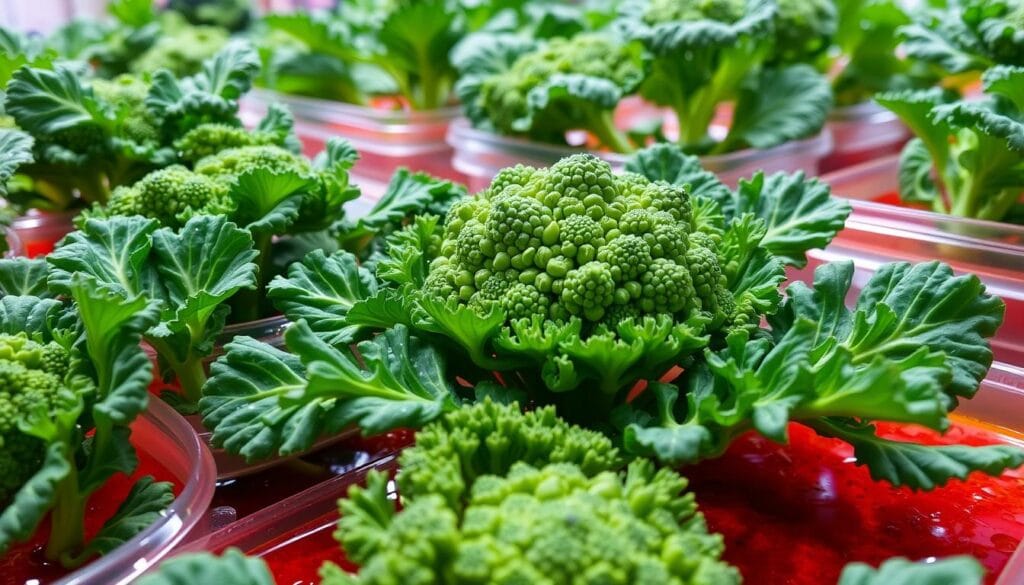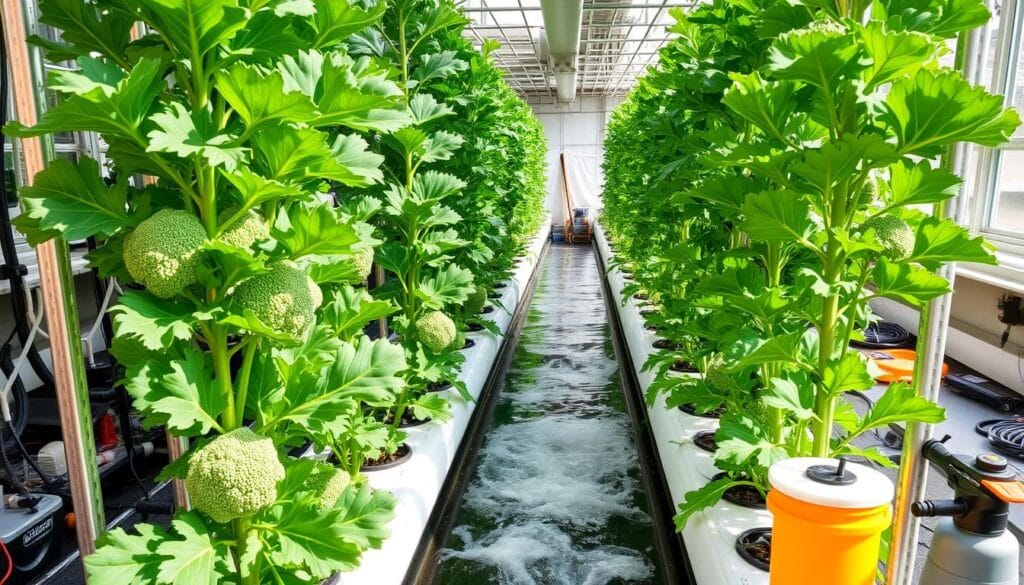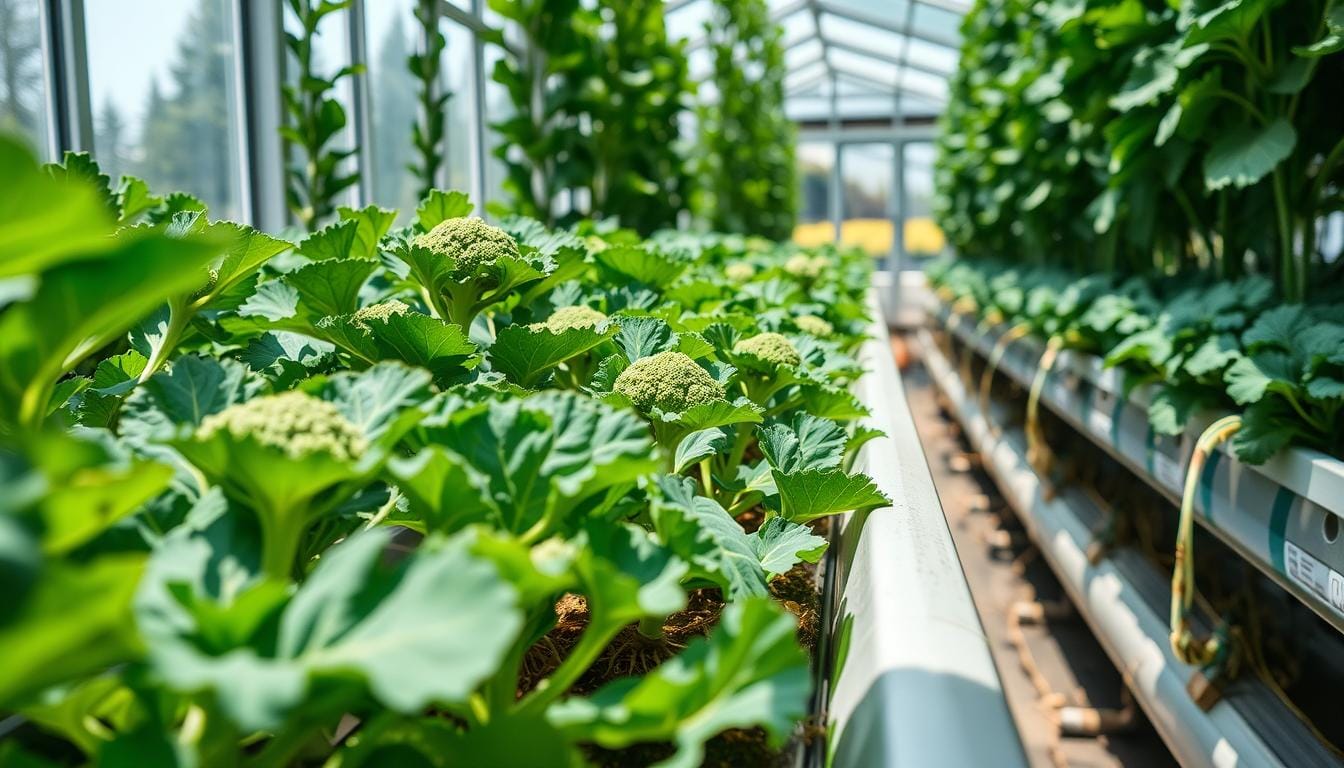Hydroponic systems are an incredible way to grow fresh produce at home, and broccoli hydroponics is no exception. Without the need for soil, this method is efficient and rewarding. My experiments have uncovered key tips to help you master growing broccoli indoors. Here are 10 easy and fun ways to boost your indoor broccoli harvest.
Key Takeaways
- Hydroponic systems can reduce water usage by up to 90% compared to traditional soil-based farming methods.
- Indoor hydroponic gardens like the Spider Farmer Smart G12 can accommodate up to 12 plants simultaneously.
- Broccoli grown hydroponically can have a growth cycle of 30 days or less for a quick turnaround.
- Hydroponic plants are healthier and safer to consume as they are not exposed to pesticides or chemicals.
- Hydroponic systems require technical expertise to manage optimal nutrient levels and pH balance.
Understanding Broccoli Hydroponics Fundamentals
Starting with soilless broccoli, growing through hydroponics opens new doors. This method has big advantages over growing in soil. You can control nutrients and the environment better, leading to faster growth and higher yields.
Benefits of Soilless Growing
Hydroponics means no soil, offering a clean and efficient way to grow broccoli. With this method, you can:
- Control nutrient levels exactly for your plants
- Adjust temperature, humidity, and air for perfect broccoli growth
- Reduce pests and diseases, keeping plants healthy
- Use space better and grow more in less area
Essential Nutrient Requirements
Broccoli requires a balanced mix of nutrients, including nitrogen, phosphorus, and potassium, for optimal growth. In hydroponics, you can adjust the nutrient solution for your plants. It’s important to check pH and EC levels often to keep plants healthy.
Environmental Control Basics
Broccoli hydroponics needs careful environmental control. Temperature, humidity, light, and air are key for plant health. Keeping the right conditions, like 60-75°F (15-24°C) and good airflow, prevents problems.
“Hydroponics enables you to optimize growing conditions for broccoli, resulting in quicker maturation and increased yields.”
Selecting the Right Hydroponic System Setup
Choosing the right hydroponic system is key to growing broccoli successfully. Many systems work well for broccoli, each with its benefits and considerations.
The Deep Water Culture (DWC) system dips roots in a nutrient-rich solution. This keeps broccoli moist and fed, helping it grow well. The Nutrient Film Technique (NFT) system flows a thin layer of nutrients over the roots. This helps broccoli absorb what it needs efficiently.
If you have little space, vertical hydroponic systems are a great choice. They use space well and are compact. For example, the Spider Farmer Smart G12 has LED lights, adjustable pumps, and smart controls. It makes growing broccoli easy and automated.
When picking a hydroponic system for broccoli, consider space, budget, and how automated you want it. Make sure the system can handle the size and weight of the plants. They need enough room and nutrients to grow big and healthy.
| Hydroponic System | Key Benefits | Considerations |
|---|---|---|
| Deep Water Culture (DWC) |
|
|
| Nutrient Film Technique (NFT) |
|
|
| Vertical Hydroponic Systems |
|
|
Think about your needs and the special features of each hydroponic system. This way, you can pick the best setup for growing healthy broccoli and getting the most from your harvest.
Optimal Growing Conditions for Hydroponic Broccoli
You must pay close attention to the environment to grow great hydroponic broccoli. The right temperature, humidity, light, pH, and EC levels are key. They help your broccoli grow strong and healthy.
Temperature and Humidity Control
Broccoli likes cooler temperatures, best between 60-65°F (15-18°C) during the day. At night, it’s okay if it cools down to 55-60°F (13-15°C). Keeping humidity at 60-70% is also important for its growth.
Light Requirements and Duration
Broccoli needs 14-16 hours of light each day to grow well. Use full-spectrum LED grow lights for the best light. This ensures your broccoli plants grow strong and vibrant.
pH and EC Levels Management
Keeping the pH between 5.5 and 6.5 and EC at 1.8 to 2.4 mS/cm is vital. Use meters and pH adjusters to check and adjust these levels. This helps your broccoli plants absorb nutrients well and stay healthy.
By carefully controlling temperature, humidity, light, pH, and EC, you can create the best environment for your hydroponic broccoli. This will lead to a rich harvest of delicious, nutritious broccoli heads.
Nutrient Solution Management and Formulation
Starting a thriving hydroponic broccoli garden begins with the right nutrient solution. This blend of nutrients is key for your plants to grow well, so you’ll need to monitor the nutrient levels as your broccoli grows.
In the vegetative phase, give your plants more nitrogen for strong leaves and stems. When they start forming heads, add more phosphorus and potassium. Keep the solution’s EC and pH levels just right for broccoli.
Many growers use pre-mixed nutrient solutions for broccoli. These formulas have the right nutrients. Regular testing and refreshing of the solution are crucial for your plants’ health.

Mastering nutrient solution management unlocks your broccoli garden’s full potential. You’ll get plenty of fresh, tasty heads with the right solution. A well-formulated nutrient solution is the key to success in hydroponic broccoli growing.
Seed Starting and Transplanting Techniques
Starting broccoli seeds is key to growing great hydroponic broccoli. By using the right methods, you can grow a healthy crop, making your indoor broccoli garden a success.
Germination Process
Place broccoli seeds in a clean, soilless mix like rock wool cubes or peat pellets. Maintain a temperature of approximately 70°F (21°C) to achieve optimal germination. Once they sprout, give them 16-18 hours of light a day to help them grow.
Seedling Care Guidelines
- Ensure the growing medium stays moist but avoid overwatering.
- Make sure there’s gentle air movement around the seedlings to help them grow strong.
- Slowly increase the light they get to prepare them for transplanting.
Transplant Timing
When your seedlings have 2-3 true leaves, about 2-3 weeks after germination, it’s time to transplant them. Be gentle when moving them to avoid harming their roots.
By following these steps for starting and transplanting seeds, you’ll set up your hydroponic broccoli garden for success and produce plenty of healthy, nutritious broccoli.
Plant Support and Training Methods
Growing broccoli in a hydroponic system requires careful plant support and training. As broccoli plants grow, they need support to stay upright, especially in vertical setups.
Using stakes, trellises, or plant clips to support your broccoli is a good idea. This keeps the stems straight, allowing for better air and light. Both are key for healthy growth and bigger heads.
It’s also important to train the side shoots to grow outwards. This improves air flow and light reach, helping all parts of the plant get the light they need for strong broccoli hydroponic techniques.
As plants get bigger, trim the lower leaves often. This helps the plant focus on growing bigger heads. You’ll get bigger and better harvests this way.
Check and adjust your support systems as your broccoli grows. This keeps the stems and roots safe. It helps your hydroponic broccoli farming stay healthy and productive.
| Hydroponic Technique | Water Savings | Land Preservation | Pest and Disease Control | Carbon Footprint Reduction |
|---|---|---|---|---|
| Broccoli Hydroponics | 70-80% | Prevents erosion, frees up land | Eliminates need for pesticides | Promotes local production |

“Hydroponics enables precise control over environmental conditions, leading to enhanced plant growth, increased yields, and more efficient resource use.”
Common Issues and Troubleshooting
Growing broccoli hydroponically can be rewarding but also comes with challenges. Knowing how to tackle common problems can help your broccoli hydroponic garden thrive. Let’s dive into some common issues and effective ways to fix them.
Disease Prevention
Keeping your hydroponic broccoli farming area clean and well-ventilated is key. Too much moisture can cause mold or fungus. Clean your grow containers, tools, and surfaces often to stop disease spread.
Pest Management
Pests like aphids, whiteflies, and cabbage loopers can harm your broccoli hydroponic techniques. Use natural pest control methods or organic sprays. Catching and fixing pest problems early is crucial for your broccoli’s health.
Nutrient Deficiencies
Watch for signs of nutrient lack in your broccoli. Look out for tip burn, hollow stems, and yellow leaves. Adjust your nutrient mix and environment to keep your hydroponic broccoli healthy.
| Nutrient Deficiency | Symptoms | Corrective Action |
|---|---|---|
| Calcium (Ca) | Tip burn, stunted growth | Increase calcium levels in the nutrient solution |
| Boron (B) | Hollow stem | Add boron supplements to the nutrient solution |
| Magnesium (Mg) | Yellowing leaves | Increase magnesium levels in the nutrient solution |
By tackling these common problems, you can keep your hydroponic broccoli garden healthy and productive. Prevention and quick action are essential for a successful broccoli hydroponic techniques garden.
Harvesting and Maximizing Yield
Timing and harvesting are key to a high hydroponic broccoli yield. Make the cut just below the head, at a 45-degree angle, around 5-6 inches down the stem. This method helps to avoid damaging the plant and encourages new growth. This helps the plant grow more side shoots for extra harvests.
Keep an eye on the plant and pick the side shoots as they grow. This way, you get more broccoli. Harvesting at the right time keeps the broccoli fresh and full of flavor.
After picking, keep the broccoli cool and humid. This keeps it fresh longer. Following these steps, you’ll get a lot of healthy broccoli from your hydroponic garden.
Factors Influencing Yield
Several things can affect your hydroponic broccoli crop:
- Nutrient solution management: The right mix of nutrients is key for growth.
- Environmental conditions: The right temperature, humidity, and light are important.
- Pest and disease control: Protecting pests and diseases is crucial for a good yield.
- Harvest timing: Picking broccoli at the right time is important for a big harvest.
Focusing on these areas can make your hydroponic broccoli garden very productive, ensuring that you have plenty of broccoli every season.
| Harvest Day | Broccoli Yield | Radish Yield | Chlorophyll Content | Anthocyanins |
|---|---|---|---|---|
| Day 10 | N/A | Significantly higher | Significantly higher | N/A |
| Day 11 | N/A | Significant decrease | N/A | N/A |
| Day 13 | Significantly higher | N/A | Significantly higher | N/A |
The table shows the best times to harvest broccoli and radish microgreens. Broccoli and radish harvested on days 13 and 10 have more yield and chlorophyll, while radish harvested on day 11 has fewer anthocyanins.
“The best time to harvest radish and broccoli microgreens is when roughly 75% of their true leaves are mature, indicating they’re ready for consumption.”
Conclusion
Hydroponic broccoli farming has many benefits. It allows for growing broccoli all year, uses less water, and lets growers control the environment. By following the right steps, like setting up the system and managing nutrients, growers can get lots of tasty broccoli.
Keeping an eye on the garden and fixing problems quickly is key. This way, broccoli hydroponics can be a success. Success lies in focusing on the finer details.
With time and care, anyone can grow their broccoli indoors. This method is great for those who want to grow food at home and sell their produce locally.
The demand for fresh, local food is growing, making hydroponic broccoli farming a great choice. It’s perfect for those who want to make the most of their space and give their community healthy broccoli all year.
FAQ
What are the key benefits of growing broccoli using hydroponics?
Hydroponic broccoli grows faster and yields more than traditional methods. It significantly lowers water consumption, using up to 90% less. Plus, it’s healthier and safer to eat because of less pesticide use and better growing conditions.
What are the essential nutrients required for hydroponic broccoli?
Broccoli needs nitrogen, phosphorus, potassium, calcium, and magnesium. To ensure the plant gets the right nutrients for health, it’s important to check and adjust the nutrient solution’s pH and EC levels.
What are the key environmental factors to consider when growing hydroponic broccoli?
Broccoli needs the right temperature, humidity, light, and air circulation. It grows best in cooler temperatures, between 60-65°F (15-18°C), and prefers a 60-70% humidity.
What types of hydroponic systems are suitable for growing broccoli?
Many systems work for broccoli, like DWC, NFT, and vertical systems. Choose based on the space, budget, and automation level you want.
How do you start and transplant broccoli in a hydroponic system?
Start seeds in a sterile medium like rock wool cubes or peat pellets. Keep the temperature around 70°F (21°C) for the most effective germination. Move seedlings to the hydroponic system when they have 2-3 true leaves, about 2-3 weeks after germination.
How do you support and train hydroponic broccoli plants as they grow?
Use stakes, trellises, or clips to support the stems and keep them upright. Train side shoots to grow outward for better air and light. Prune lower leaves as the plant grows to focus on head development.
How do you prevent and address common issues in hydroponic broccoli cultivation?
Keep the area clean and well-ventilated to prevent disease and avoid too much humidity. Stay vigilant for pests, including aphids and whiteflies. Use good pest management. Adjust the solution and environment to fix nutrient issues.
How do you properly harvest and store hydroponic broccoli?
Harvest broccoli when the head is fully grown but before it starts to flower. Cut the head at a 45-degree angle, about 5-6 inches below the surface. This encourages side shoots. Store broccoli in cool, humid conditions to keep it fresh.

